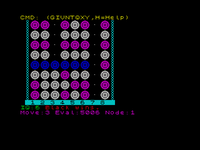Commodore VIC-20

The VIC-20 – a "family" version of the PET series (using the same microprocessor and Basic language) – was the first computer to sell more than one million units. Once dubbed the MicroPET during the 1980 Computer Electronics Show, it later became known as the VIC-20. VIC referenced the VIC-I (Video Interface Chip) chip used for graphics and sound. There does not seem to be any obvious rationale behind the usage of the number 20, other than the fact that it was close to the 22 characters per line and to the combined RAM and ROM memory in the machine (5 KB RAM + 16 KB ROM), or the total 8 KB Basic, 8 KB Kernel and 4 KB Character maps...
Regarding the name, Michael Tomczyk, (manager of the VIC project) recalls:
"VIC sounded like a truck driver, so I insisted on attaching a number. I picked ‘20’ and when Jack Tramiel asked, ‘Why 20?’ I replied, ‘because it's a friendly number and this has to be a friendly computer.' He agreed. The number 20 has no relation to any technical feature -- just my idea of a friendly sounding number. That sounds a bit bizarre looking back on it, but we did a lot of things by instinct in those days."
The VIC-20 was designed by Bob Yannes who also created the SID chip for the C64. He later joined Ensoniq to design synthesizers.
The Video Interface Chip (or ‘VIC’ as it is commonly called), is one of the most important silicon chips in the VIC-20 microcomputer, coming second only to the 6502A microprocessor itself. The VIC is a specially constructed input-output (I/O) chip that offers a large variety of functions, but as suggested by its name, is primarily concerned with the production of the video output signal. It was originally intended to be sold to third-party manufacturers for use in video game machines. Demand for the chip was low, and so Commodore decided to make their own system to recoup their losses.
The VIC-20 was initially launched in Japan in late 1980 (under the ‘VIC-1001’ name) with a Japanese 'Katakana' set of characters. It was subsequently released in North America in May of 1981. Though these are the "official" release dates, several prototypes of the Commodore VIC-20 were reportedly available in late 1979. These early machines offered only 4 KB of RAM and used a different set of game cartridges.
Thanks to the colorful graphics and low cost, the VIC-20 was an immediate success. At its peak, more than 9000 units rolled off the assembly line each day. Adding to its success was the fact that it was the first color computer to break the $300 (USD) price barrier.
A wide range of peripherals and software were developed for the VIC-20. The failed Commodore 16 eventually became the successor of the VIC-20.
(Note: Description used with courtesy of http://www.old-computers.com)
Recent releases:
|
|
FaiRLane | Dec 2025 | |
|
|
JavaJack | Dec 2025 | |
|
|
maba | Dec 2025 | |
|
|
Shiela | Dec 2025 | |
|
|
Shiela | Dec 2025 | |
|
|
Lechuck | Dec 2025 | |

|
STK | Dec 2025 | |

|
ssusnic | Dec 2025 | |

|
orac81 | Nov 2025 | |
|
|
Warlord / phObos Team | Feb 2025 | |

|
juN3bula / N3U | Feb 2025 | |

|
orac81 | 2025 | |

|
anderszapac | Dec 2024 | |

|
anderszapac | Dec 2024 | |

|
JavaJack | Dec 2024 | |

|
Lechuck | Dec 2024 | |

|
FaiRLane | Dec 2024 | |

|
Slaxx / Quantum | Oct 2024 | |
|
|
Warlord / phObos Team | Jul 2024 | |

|
Slaxx / Quantum | Jul 2024 | |

|
Desire | Mar 2024 | |

|
TôBach / Furry Trash Group ^ Poo-Brain ^ Rift ^ Slipstream ^ The Unstoppable Hacker Bunch | Feb 2024 | |

|
ISO | Feb 2024 | |

|
spq | Feb 2024 | |

|
orac81 | 2024 | |

|
Alan Monroe | Dec 2023 | |

|
Masterware Entertainment | Dec 2023 | |

|
Bruce Gregory | Dec 2023 | |

|
Erik Hooijmeijer | Dec 2023 | |

|
FaiRLane | Dec 2023 |